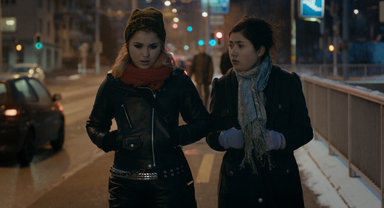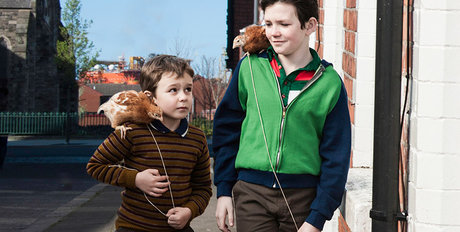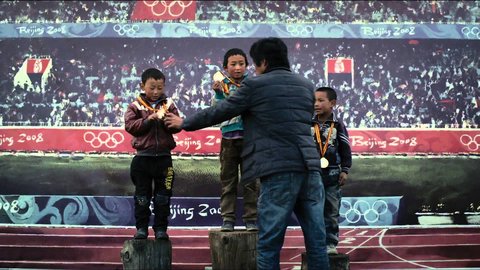Andrew Rostan was a film student before he realized that making comics was his horrible destiny, but he’s never shaken his love of cinema. Every two weeks, he’ll opine on either current pictures or important movies from the past.
The Outlier of the Oscars
The Short Films are the Academy Awards that too easily get overlooked. Casual moviegoers recognize the candidates in almost every major category and can often pick out most of the Animated Feature, Documentary, and Foreign Language Film nominees, but for the ten minutes the Shorts take over the program, 99% of the time movies people have never heard made my equally anonymous filmmakers receive the honor that has proved elusive to so many titans of history.
It is a deserved honor, one I was reminded of when I attended a screening of the Live-Action Short nominees at the Landmark Century. I’d wanted to use my moviegoing dollars to support the ambitious men and women who made the nominees, but eventually I was overtaken by memory and reflection, remembering my own experiences making two short films in college and seeing the lessons I learned about this art play out on the big screen in front of me.
Challenges and Triumphs
The difficulties in producing short films go beyond the obvious facts of lower budgets, limited access to locations, and tight schedules that necessitate improvising new scenes if problems emerge. The essential issue is that the short film as a dramatic story has to be every bit as meticulously planned as the production logistics.
Though this statement was written 300 years before the first movie camera was invented, Michel de Montaigne, the great humanist scholar, summed up the necessary goal of the short film when he apologized to a friend for writing a long letter because he didn’t have time to write a short one. A feature can have dead spots and serious issues yet still be dramatically satisfying if it conveys its theme or completes its arc. The short film cannot afford to have dead spots or extraneous material when it has thirty minutes or less to round off its story. We the audience must see the completion of an arc, or the one perfect payoff to the set-up, and for the short to work, near-perfect writing is required as much as good luck in the production.
This being said, there are definitely ways to meet these challenges and make a thrilling, memorable short, and the best of this year’s nominees rise to the occasion. For example, following the old adage that the more limitations you place on yourself, the more creative you become, two of this year’s shorts are almost entirely confined to a single set. Both films introduce their premise and build to a final pay-off that the lone location helps make possible.
The more interesting is the Chinese-French production Butter Lamp. Comprised entirely of long, static takes, Butter Lamp chronicles a day in the life of three enterprising young men who show up in provincial Chinese towns and take pictures of the locals—many of whom are senior citizens—wearing “modern” garb and posing against backdrops of Disneyland, Hong Kong shopping districts, and the country’s historic landmarks. The film is delightfully absurd until the final reveal, which explains why such an unusual business would appeal to the townspeople.
The British film The Phone Call sneaks in a few extra locations at the beginning and the end, but is mostly confined to the headquarters of a crisis hotline, where a dedicated employee finds herself in conversation with a lonely widower during his suicide attempt. The one setting both accelerates the suspense—she has to stay on the line to keep him talking—and keeps the audience focused on the drama, as the phone call keeps going and the participants find they have much in common. It helps, of course, that the film features the always welcome Sally Hawkins and the gentle but firm voice of Jim Broadbent.
 A more ambitious but every bit as successful picture is the Parvaneh, which uses multiple mundane locations in Zurich—including train stations, department stores, highways, and night clubs—and lends them a layer of grandeur. Director Talkhon Hamzavi tells the story of an Afghan teenager living in the Swiss countryside who must wire money home to her family, travels to the big city for the first time, and meets an upper-class girl with whom she forms an unexpected connection. The setting becomes larger than life because Hamzavi shows it to us through the inexperienced Parvaneh’s eyes, and the story is compelling because in 25 minutes the two female leads are rounded off so well I felt as if I’d gone to school with them.
A more ambitious but every bit as successful picture is the Parvaneh, which uses multiple mundane locations in Zurich—including train stations, department stores, highways, and night clubs—and lends them a layer of grandeur. Director Talkhon Hamzavi tells the story of an Afghan teenager living in the Swiss countryside who must wire money home to her family, travels to the big city for the first time, and meets an upper-class girl with whom she forms an unexpected connection. The setting becomes larger than life because Hamzavi shows it to us through the inexperienced Parvaneh’s eyes, and the story is compelling because in 25 minutes the two female leads are rounded off so well I felt as if I’d gone to school with them.
What Doesn’t Work
 The other nominees fall victim to poor storytelling. The Israeli film Aya is set up along the same lines as Parvaneh—two very different people have a chance encounter—but is structured and written in a way where it goes on twice as long as it should and is dominated by elliptical, ultimately pointless dialogue. (It does at least feature a surprisingly mesmerizing scene in which a man plays air piano on a woman’s knee.) Finally, Boogaloo and Graham takes a wonderfully filthy yet charming story about two profane children who grow devoted to their pet chickens under the gaze of their slightly dysfunctional but fiercely loving parents, then botches the execution by, in a film that’s short enough, adding a completely unnecessary layer involving the IRA and the British army that’s supposed to add “weight” but is so out of place it nearly ruins all the joy.
The other nominees fall victim to poor storytelling. The Israeli film Aya is set up along the same lines as Parvaneh—two very different people have a chance encounter—but is structured and written in a way where it goes on twice as long as it should and is dominated by elliptical, ultimately pointless dialogue. (It does at least feature a surprisingly mesmerizing scene in which a man plays air piano on a woman’s knee.) Finally, Boogaloo and Graham takes a wonderfully filthy yet charming story about two profane children who grow devoted to their pet chickens under the gaze of their slightly dysfunctional but fiercely loving parents, then botches the execution by, in a film that’s short enough, adding a completely unnecessary layer involving the IRA and the British army that’s supposed to add “weight” but is so out of place it nearly ruins all the joy.
Whatever their merits, I admire and celebrate all these filmmakers who worked hard with less money, less power, and less resources but realized at least something of their visions. And I feel a bit sorry for those who did not get to see these movies. Not only did you miss some fine cinema from promising talent, but also your Oscar pool might be a little more of a crapshoot.
Pictures from ytimg.com, sehschueste.de, and Toronto International Film Festival





